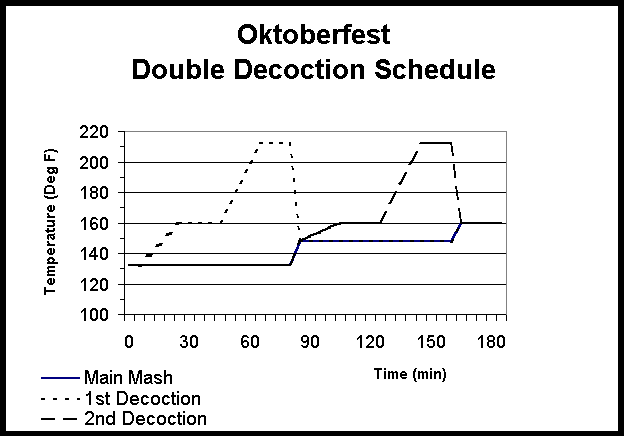
(editor's note: This special edition of the WIZARDS Newsletter is being published to coincide with Phil's talk on brewing an Octoberfest beer, which was given during the March club meeting. The talk was given in anticipation of the club's annual Octoberfest tasting, where we taste, compare and rate home-brewed and commercially brewed Octoberfests. Two years in a row Phil has come out on top so we asked him to tell us how its done. Phil prepared the following article and photos to accompany his presentation.)
Oktoberfest
Brewing Notes by Phil Tatro
Introduction:
As homebrewers, we often tend to think one to three months ahead when developing our brewing schedules. Many times I have been asked in September for advice on brewing an Oktoberfest beer. My first advice, especially for anyone who does not have a refrigerator for controlling fermentation temperatures, is consider brewing in March. This allows for brewing at lager temperatures when cellars are cool, and also allows plenty of time for conditioning. The following notes are a compilation of information from different sources as noted below, and also from my own personal experience brewing this style for seven years.
History:
The Vienna style of beer was developed during the 17th century in Vienna, then the commercial and cultural center of the Austro-Hungarian Empire. Included in the empire in addition to the present day countries of Austria and Hungary, was the region of Bohemia, and the town of Pilsen, which had a great influence on the brewing style in Vienna. In 1841, a collaboration between Anton Dreher in Vienna and Gabriel Sedelmayr in Munich brought the first bottom fermenting yeast from Bavarian monasteries into commercial brewing. This new strain of yeast reached the city of Pilsen a year later, in 1842. The Vienna and Münchner beer styles progressed in parallel in their respective cities. The former style possessed a deeper color than the beers brewed in Pilsen, but was not as deep as the latter style brewed in München. Note for comparison, typical Lovibond ratings of the respective malts; Pilsen - 2.5°L, Vienna - 4°L, and München - 8°L. Noble hops were used in both styles, with Saaz being the hop of choice in Vienna, while Hallertauer Mittelfrüh and Tettnanger were preferred in München, both primarily a matter local availability. As time progressed, a primary difference between the two styles evolved with the onset of refrigeration. The Vienna style moved toward year round production, while the Münchner style retained the traditional Märzen brewing schedule, brewing the beer in March and cellaring the finished product for the beer festivals in October. It is this Münchner style Oktoberfest beer that is the topic of this discussion.
Style Characteristics:
The AHA beer style guidelines indicate that Oktoberfest beers are characterized by a medium body and a broad range of color. Oktoberfest beers range from golden to reddish brown. Sweet maltiness should dominate slightly over a clean hop bitterness. Malt character should be toasted rather than strongly caramel. Hop flavor should be low but notable. Fruity esters are minimal, if perceived at all. Diacetyl and chill haze should not be perceived.
O.G. 1.050-1.056
F.G. 1.012-1.020
IBU 18-25
Color 4-15 (SRM)
Ingredients:
Grain Bill
The grain bill for an Oktoberfest should be limited to basic German malts; Pilsen, München, and Crystal. I use a 50/50 mixture of German Pilsen and München for my base malt. I have based my recipe on 38 points/pound/gallon for Pilsen malt and 35 points/pound/gallon for München. Use enough base malt to reach the target gravity of 1.050-1.056. My experience indicates that an increased efficiency of five percent or more can be expected using a double decoction versus a single step infusion mash. I also add one pound of German Crystal malt, consisting of a 50/50 mixture of Iight and dark crystal.
With the exception of the German dark crystal, all these grains have a very low color rating. Yet, a traditional Oktoberfest beer will have a color ranging from golden to copper to reddish brown, with something mid-range probably being most common. This is because a large portion of the color in an Oktoberfest beer comes from the decoction mashing process. If you do not use a decoction mash, I recommend increasing the percentage of München malt for the base malt, and a higher percentage of dark crystal for the crystal malt. While some texts reference highly roasted malts such as chocolate malt, I do not believe these malts are appropriate for this style. If you do use roasted malt, use it only in very small quantities to adjust color. If used in higher quantities, the grain will add a bitterness from the burnt caramel characteristic of the grain that is inappropriate for the style.
Hops
Traditional German hops are most appropriate for an Oktoberfest beer. Noble German hops such as Hallertauer Mittelfrüh and Tettnang Tettnanger are good choices.
Where German Hallertauer Mittelfrüh is not commonly available, other German varieties such as German Hallertauer Hersbrucker, or American descendants of Hallertauer Mittelfrüh (Mt. Hood, Liberty, and Crystal) are excellent substitutes. The Mt. Hood, Liberty, and Crystal varieties have been developed by the USDA breeding program aimed at developing a hop with "noble characteristics" that would grow well in the United States. Note that American Hallertauer is considered a poor substitute for German Hallertauer, hence the effort of developing alternate varieties. Some of the literature indicates that Liberty and Crystal are the best American choices, with Mt. Hood a very close second. Additional German varieties Hallertauer Tradition and Spalter Select should be available in the near future as Hallertauer alternates. These varieties have been bred in Germany to replace the Hallertauer Mittelfrüh and Hersbrucker with more disease resistance.
As for Tettnanger, German Tettnanger is preferred, but the American variety is an adequate substitute.
Yeast
There are several yeast strains available that are suitable for an Oktoberfest beer. My familiarity with available yeast strains is limited to Wyeast. Similar strains should be available from other companies. I have used Wyeast München (#2308), Bavarian (2206#), and Czech Pils (#2278). Wyeast Bohemian (#2124) may also be worthy of consideration. George Fix recommends the München and Bavarian yeasts for the round malty flavors they produce. Daryl Richman recommends the München also. He indicates mixed reports with the Bavarian, indicating a tendency to produce high levels of diacetyl (butter, butterscotch, or toffee), and he indicates the Bohemian tends to produce more esters. My experience is that the Czech Pils has given the greatest malt profile, and that the yeast ferments well as low as 46°F. It does produce a lot of sulfur, but the sulfur dissipates with conditioning, and I have never had a problem with sulfur in the finished product. Note that at 46-50°F, any of these yeasts will ferment slowly. I usually allow two weeks in the primary, and at least two weeks in the secondary for this style of beer. I presently have a Maibock in fermenting which still has a layer of krausen after three weeks in the secondary. For those who do not have a cool place to ferment, the Wyeast California (#2112) is recommended over the German lager yeast strains. I would still try to keep the fermentation as cool as possible, but good results are possible up to 68°F with this yeast. While I have not used this yeast myself, I have tasted some excellent German style beers brewed with this yeast
Mash Schedule:
A double decoction is most appropriate for brewing an authentic Oktoberfest beer. The primary reason for using a decoction mash is ensure adequate formation of and retention of melanoidins. Melanoidins are compounds that provide both color, and more importantly the malty flavor and aroma typical of an authentic Oktoberfest beer.
During the boiling of the decoction mash, a process known as the Maillard reaction occurs. Technically, the process results in the formation of polymeric compounds from amino acids combining with simple sugars. In acidic environments such as the mash tun, the molecules are converted to ketosamines by a second process known as Amadori Rearrangement. Finally, under the intense heat of boiling the decoction mash, the molecules are converted to melanoidins. In practical terms, the process yields a darkening of the malt, and an intense malty flavor.
The intense heat required for melanoidin formation is also present in the brew kettle during boiling of the wort, and some formation will occur here. However, the process is much more effective during the mash. This is because of the higher concentration of amino acids and reducing sugars, and the more acidic environment. The molecules formed from the amino acids and simple sugars are unstable compounds, and most will return to the constituent ingredients before reaching the kettle unless a decoction mash is utilized.
A large range of decoction mash schedules are available from a number of resources. These schedules vary significantly in complexity, and subsequently in the length of time the brewer will need to dedicate on brew day. In my experience, the most common reason given by homebrewers for avoiding decoction mashing is the extra time requirement. The major factors affecting the length of the mash process are the number of decoctions drawn, and the number of rests used for each decoction.
The longest mash schedule I have seen published is a triple decoction schedule for brewing bock beer in Darryl Richman’s book, which logs in at six and one-half hours. I have used this schedule once for a doppelbock, and quickly decided that there must be a simpler and quicker way to obtain the benefits of a decoction mash. The mash schedule below is where I have evolved to after a few years of research, discussions, and my own trial and error. This schedule logs in at approximately three hours. So, for a homebrewer who utilizes a 60 minute single step infusion mash, this double decoction schedule would add two hours to the brew day.

As indicated above, the number of decoctions drawn and the number of rests used for each decoction drive the schedule time. This schedule uses a double decoction and one rest per decoction mash. The double decoction mash provides adequate melanoidin production for an Oktoberfest beer. As for the single rest for each decoction mash, modern continental malts are much more highly modified than when the decoction method was originally developed. Contrary to some misinformation, München malt has more than adequate enzyme content, and will typically convert even with a 20 minute rest. I have in the past performed an iodine test on the decoction mashes for starch conversion, but experience has indicated to me that this step is not necessary. Twenty minutes is enough for nearly complete conversion, and I have noticed no significant difference in my end product since eliminating the starch test.
If a decoction mash is not used, it is important to take additional measures to increase melanoidin content in the finished beer. One way to accomplish this is to use a higher percentage of malts that will contribute more Melanoidins to the mash. Using a higher percentage of München malt in the grain bill will accomplish this, and also will contribute additional color which will be lacking without a decoction mash. Additional dark crystal should also be added for the same reasons. Another malt receiving more discussion in recent years is Melanoidin malt. This malt has a color content on the order of 35°L. It has an extract capacity of 33 points/pound/gallon, however, the heat used to produce this grain yields a very low enzyme content. Discussions I have seen indicate that one or two pounds may be added to the grain bill to provide color and melanoidin content to beers where a decoction method is not utilized.
A second way to increase the melanoidin content is to increase the boil time for the wort. This method has limited capability due to the lower concentration of amino acids and reducing sugars in the wort compared to the mash. To increase concentrations during the boil, it may be preferable to boil from a normal starting volume and end at a lower than normal volume. Adding water back at the end of the of the boil, rather than adding water at the beginning of the boil.
A third option to increase the melanoidin content is to use a single decoction step to increase the mash temperature for mash out. Since the mash conversion is already complete, a rest is not required for the decoction. The decoction can be heated directly from the mash temperature to a boil over the course of twenty minutes, followed by fifteen to twenty minutes of boiling the mash. This method would add only 35 to 40 minutes over a single step infusion mash; less for those who would otherwise heat for mash out using an alternate method. For those using a single step infusion, I recommend a fairly high mash temperature of 156°F to produce a high dextrin content in the beer, which will contribute to the body and mouthfeel of the finished product.
Mechanics of Decoction Mashing:
The decoction mash serves two purposes. The first is to increase melanoidin content as described above. The second is to heat the main mash, raising the mash temperature from one mash temperature to the next. Most mash schedules are devised so that the volume of each decoction mash should be one-third the volume of the total mash. The schedule presented above is no different. There tend to be two main questions regarding decoction mashing. How much mash to draw off for the decoction, and how thick should the decoction mash be?
Determining exactly how much grain to draw for the decoction mash is a matter of trial and error, and like most homebrewing processes, will vary from one brewer's equipment to another's. When estimating for the first time, it is best to err on the side of drawing a larger than necessary decoction mash. If the mash is too large, the main mash will be raised to higher than desired temperature for the second rest. This can be corrected by drawing a smaller second decoction mash. If too small a decoction is drawn for the first mash, it may not be possible to draw a large enough second decoction to raise the main mash to the desired final temperature. For example, when aiming for a second rest at 148°F, it is preferable to be too high at 152°F, than too low at 144°F.
Determining how thick should the decoction mash be is a also a matter of trial and error. For reference, Richman indicates a liquor/grain ratio of 1.4 quarts/pound for mash in, and recommends that the decoction should be drawn to have a ratio of 1 quart/pound. The mash in ratio of 1.4 quarts/pound allows for evaporation during the mashing process. This would of course be a greater concern with the six and one-half hour mash schedule, than with a three hour schedule.
My system dictates that I always have a thick mash on the order of 1 quart/pound, as my five gallon mash tun will hold about 12 to 13 pounds of grain at this ratio. Just the same, I draw a thicker decoction than my main mash. To draw the decoction, I use a three quart kitchen pot as a ladle. I fill the pot with mash, and then hold the pot against the side of my mash tun, allowing the liquor to drain out along the side of the mash tun. After the majority of the liquor has drained, I transfer the mash to a second pot to heat the decoction mash. With my brewing equipment, I obtain the desired temperature steps using a nearly full eight quart pot for the decoction mashes. The mash should be fairly thick to stir, but must contain adequate liquor to prevent scorching the grain when heating the decoction mash.
When heating the grain, it is important to heat the grain slowly. Particularly when heating the grain to the rest temperature. It is important not to create hot spots in the mash that will kill the enzymes before converting the mash. Constant stirring is recommended. Also, a burner with fine heat control is necessary to prevent heating the mash too quickly. I heat my decoction mash on the kitchen stove. Finding a burner temperature for heating the mash is yet another trial and error in decoction brewing. On my old electric stove, setting the burner between medium and medium-high was perfect for heating from 132°F to 160°F over 20 minutes. Unfortunately, we bought a new stove this year and I am back too trial and error finding the right setting for the new stove. For the first few attempts, it is worthwhile to remove the decoction from the heat at 155°F, stir, and let the temperature settle out before proceeding up to 160°F.
To hold the temperature during the decoction rest, I preheat my oven on "warm" for a couple minutes, turn it off, and place the mash in the oven. Don't worry too much about the oven temperature. The importance of preheating the oven is just to warm it, so that it does not steal heat away from the decoction mash.
The brewer does not need to be as attentive when heating the decoction mash to boiling, as when heating to the rest temperature. The heating should still be slow over 20 minutes, but constant stirring is not required. Occasional stirring is still recommended to prevent scorching on the bottom of the pot. Once a steady boil has been reached, the boil should be maintained for 15 minutes. I use a 10 minute boil for lighter beers such as Pilsener and Hefeweizen to avoid too much darkening of the mash. By contrast I use 20 minutes for Bocks and Doppelbocks, where color is not an issue, and I want to boost up the malty characteristics of the beer. As the temperature of the mash approaches 212°F, the liquor will start to boil before the mash reaches 212°F. At this point it is important to stir more frequently to transfer heat from the liquor into the grain. If the decoction mash was drawn the proper consistency, the liquor will bubble up in small pools through the grain. If the mash is too thick, the boiling liquor will not be visible. I expect however, that other problems will have been apparent during heating. If the grain level is below the level of the boiling liquor, then the mash has likely been drawn too thin.
After boiling, return the decoction mash to the mash tun and stir to mix the mashes. The mash should be stirred in quickly to prevent hot spots from killing enzymes in the main mash. Wait long enough to for the main mash temperature to stabilize, and repeat the process. I typically wait five minutes before drawing the second decoction.
After the second decoction is returned to the main mash, wait for starch conversion, and then proceed as with any other brewing endeavour. I typically wait 20 minutes for the main mash to convert, and then proceed to the lauter tun. Since the mash is already at 160°F, I skip the mash out step and proceed directly to recirculation.
Malt Extract:
Brewing an Oktoberfest from malt extract presents many of the same challenges as brewing one with a single step infusion mash. To obtain some of the malty characteristics it is important to steep grain in the brewing water before adding the malt extract. Steeping München and crystal grains will provide some of the flavor characteristics missing in the malt extract, and will also provide some melanoidins from the München malt. Since even the pale malt extract tends to produce an golden to amber beer, light crystal is recommended for the crystal malt. The Melanoidin malt now available may also be a good choice for steeping. As noted above however, I do not have any experience with this grain.
Recipes:
The recipes attached are fairly straightforward to follow. The all grain gravity is based on 38 points/pound/gallon for Pilsen malt, 35 points/pound/gallon for München malt, and 24 points/pound/gallon for crystal malt. The recipe will yield 5.25 gallons of wort with a 70 percent efficiency.
The extract recipe also is straightforward. Caution is given that three pounds of grain should not be placed in a single muslin bag. The grain is considerably heavier than three pounds when it is time to remove it from the water, and having the bag break makes for an unpleasant job trying to separate the grain from the liquor.
Fermentation:
The wort should be fermented at a temperature appropriate for the yeast strain. For the German lager yeasts listed above, a temperature as close to 46°F as possible should be used. Fermentation at this temperature tends to be slow, and two weeks in the primary followed by two to three weeks in the secondary will likely be required to complete fermentation. If you plan to lager the beer, do not decrease the temperature until after the secondary fermentation is complete. At present I do not have a refrigeration system to allow lagering at 34°F, so I have no experience to share on this aspect. I bottle when fermentation is complete and leave the beer down cellar until fall. My cellar seldom rises above 68°F, and temperature changes tend to be one slow cycle from 46°F up to 68°F and back over one year.
Summary:
I recommend using quality products, and following a traditional double decoction mash. Brew in March. Lauter, boil, and ferment as per usual for your system. Condition the beer over the summer. You know the rest. Enjoy!
Sources:
Fix, George and Laurie, :Märzen, Oktoberfest, Vienna: Classic Beer Style Series No. 4", Published by Brewers Publications, Inc., Boulder, CO, 1991.
Garetz, Mark, "Using Hops: The Complete Guide to Hops for the Craft Brewer," Published by Hoptech, Danville, CA, 1994.
Richman, Darryl, "Bock: Classic Beer Style Series No. 9", Published by Brewer’s Publications, Inc, Boulder, CO, 1994.
Wyeast Laboratories, Inc, Mt. Hood, OR.
Oktoberfest (All Grain)
Ingredients:
5.0# Ireks Pilsen malt
5.0# Ireks München malt
0.5# Ireks Light Crystal malt
0.5# Ireks Dark Crystal malt
1.75 oz. 4.7% Liberty (60 min) -- Notes 1,2
0.25 oz. 4.8% Tettnanger (10 min) -- Notes 1,3
Wyeast Czech Pils (#2278)
O.G. = 1.052
F.G. = 1.015
Estimated Color - 18 SRM -- Note 4
Estimated Bitterness - 23 IBU
Mash Schedule:
Use a double decoction mash schedule.
Notes:
Ferment for 2 weeks in primary at 46-50°F. Ferment in secondary 2 to 3 weeks at 46-50°F.
Oktoberfest (Extract)
Ingredients:
6.6# Ireks Pale or Bierkellar Pale Malt Extract
2.0# Ireks Munchener malt
1.0# Ireks Light Crystal malt
2.5 oz. 4.7% Liberty (60 min) -- Notes 1,2
0.25 oz. 4.8% Tettnanger (10 min) -- Notes 1,3
Wyeast Czech Pils (#2278)
O.G. = 1.051
F.G. = 1.015
Estimated Color - 18 SRM
Estimated Bitterness - 23 IBU
Brewing Notes:
Notes:
Ferment for 2 weeks in primary at 46-50°F. Ferment in secondary 2 to 3 weeks at 46-50°F.
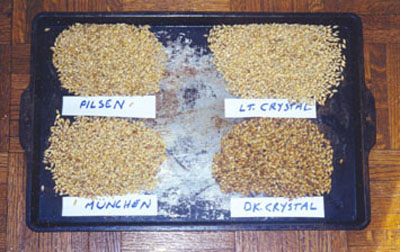 | 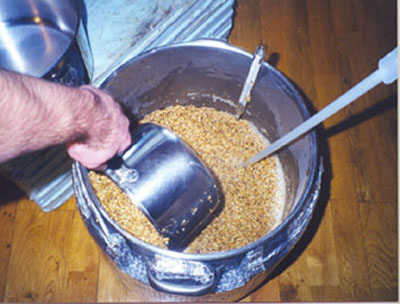 |
| The Octoberfest Grain Bill | Preparing the first decoction |
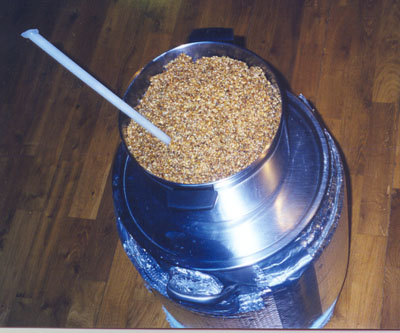 | 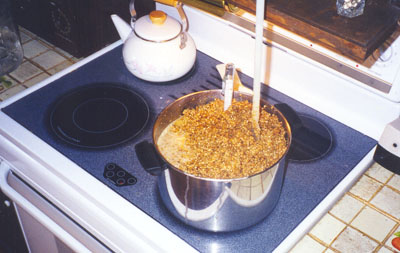 |
| The first decoction (before the boil) | The first decoction at the conversion rest |
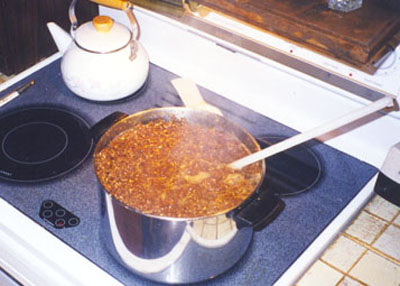 | 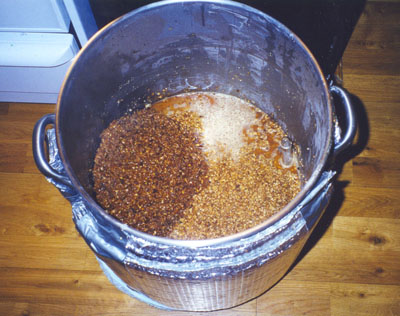 |
| Boiling the first decoction (at the end of boil) | The first decoction added back to the mash |
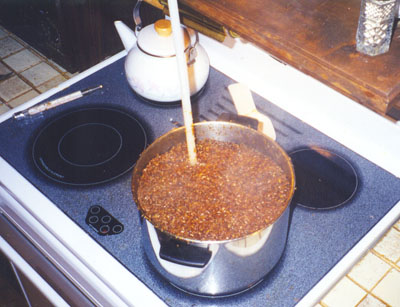 | 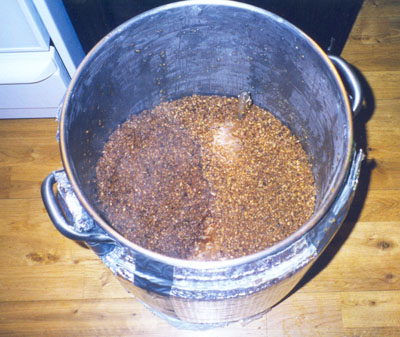 |
| Boiling the second decoction | The second decoction added back to the mash |